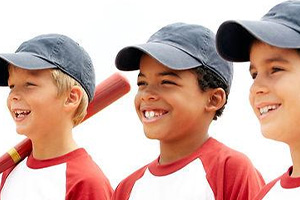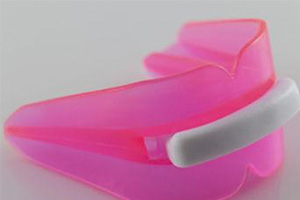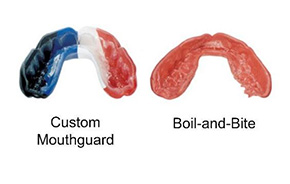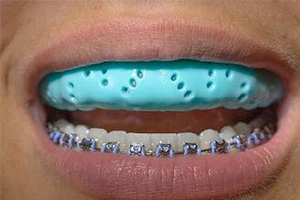
Imagine what it would be like if you suddenly lost one or two of your front teeth. Smiling, talking, eating—everything would suddenly be affected. Knowing how to prevent injuries to your mouth and face is especially important if you participate in organized sports or other recreational activities.

Mouthguards, also called mouth protectors, help cushion a blow to the face, minimizing the risk of broken teeth and injuries to your lips, tongue, face or jaw. They typically cover the upper teeth and are a great way to protect the soft tissues of your tongue, lips and cheek lining. “Your top teeth take the brunt of trauma because they stick out more,” says Dr. Thomas Long, a private practice dentist and team dentist for the Carolina Hurricanes professional hockey team. “Your bottom teeth are a little more protected because they are further back.”
When Should You Wear a Mouthguard? When it comes to protecting your mouth, a mouthguard is an essential piece of athletic gear that should be part of your standard equipment from an early age While collision and contact sports, such as boxing, are higher-risk sports for the mouth, any athlete may experience a dental injury in non-contact activities too, such as gymnastics and skating.

TYPES OF MOUTHGUARDS: The best mouthguard is one that has been custom made for your mouth by your dentist. However, if you can’t afford a custom-made mouthguard, you should still wear a stock mouthguard or a boil-and-bite mouthguard from the drugstore. Learn more about each option:
Custom-made: These are made by your dentist for you personally. They are more expensive than the other versions because they are individually created for fit and comfort.
Boil and bite: These mouth protectors can be bought at many sporting goods stores and drugstores and may offer a better fit than stock mouth protectors. They are first softened in water (boiled), then inserted and allowed to adapt to the shape of your mouth. Always follow the manufacturers’ instructions. These are inexpensive and come pre-formed, ready to wear. Unfortunately, they often don’t fit very well. They can be bulky and can make breathing and talking difficult.

Protecting Your Braces: A properly fitted mouthguard may be especially important for people who wear braces or have fixed bridge work. A blow to the face could damage the brackets or other fixed orthodontic appliances. A mouthguard also provides a barrier between the braces and your cheek or lips, which will help you avoid injuries to your gums and cheeks. Talk to your dentist or orthodontist about selecting a mouthguard that will provide the right protection. Although some mouthguards only cover the upper teeth, your dentist or orthodontist may suggest that you use a mouthguard on the lower teeth if you have braces on these teeth. If you have a retainer or other removable appliance, do not wear it during any contact sports.

Mouthguard Care and Replacement: Talk to your dentist about when is the right time to replace your mouthguard, but replace it immediately if it shows sign of wear, is damaged or ill fitting. Teens and children may need to replace their mouthguards more often because their mouths are still growing and changing.
Between games, it’s important to keep your mouthguard clean and dry. Here are some tips for making sure your mouthguard is always ready to go:
- Rinse before and after each use or brush with a toothbrush and toothpaste.
- Regularly clean the mouthguard in cool, soapy water. Then, rinse it thoroughly.
- During your regular dental checkups, bring your mouthguard for an evaluation. Your dentist may also be able to give it a thorough cleaning.
- Store and transport the mouthguard in a sturdy container that has vents so it can dry and keep bacteria from growing.
- Never leave the mouthguard in the sun or in hot water.
- Check fit and for signs of wear and tear to see if it needs replacing.
- Some mouthguards have fallen victim to family pets, who see them as chew toys.
- Store your mouthguard and case somewhere your pet cannot get to it.
